The City is supporting the StreetSmartsTO initiative to help Toronto’s growing community of people that cycle. Communities, BIAs, and organizations are encouraged to request free workshops.
The Toronto Cycling Handbook includes all the basics of cycling safety tips, equipment, traffic laws, theft prevention and safe cycling habits, and is available in 14 different languages.
The Family Edition of the Toronto Cycling Handbook covers everything you need to know about cycling during pregnancy and with babies and toddlers, teaching children to ride, or supporting children or teenagers to cycle to school.
See the information below to learn how to practice safe cycling on Toronto’s streets, stay visible to other road users in all seasons, and cycle with children.
Making Right Turns at Intersections
Where a bicycle lane or cycle track is separated by a solid white line, drivers should not merge into the lane; instead, they must yield to people cycling and turn from the vehicle lane instead.
Bicycle lanes or cycle tracks that have a dashed line leading to the intersection allow drivers to fully enter the lane when it is safe and clear of people cycling. People cycling must then pass the turning vehicle on the left or wait behind the vehicle until the lane is clear.
Entering a Street with a "Bicycles Excepted" Sign
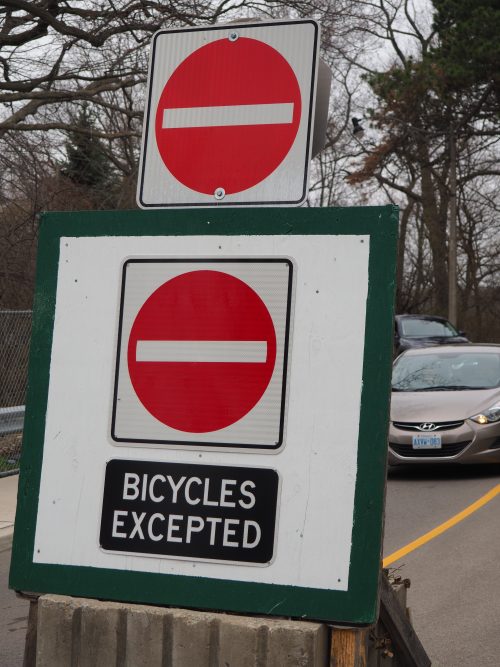 For a one-way street with a contra-flow lane traveling in the opposite direction of motor traffic, the “bicycles excepted” sign is utilized. This tells drivers that they cannot legally travel in the specified direction, while allowing people cycling to use the designated contra-flow facility.
For a one-way street with a contra-flow lane traveling in the opposite direction of motor traffic, the “bicycles excepted” sign is utilized. This tells drivers that they cannot legally travel in the specified direction, while allowing people cycling to use the designated contra-flow facility.
Approaching Transit (TTC) Stops
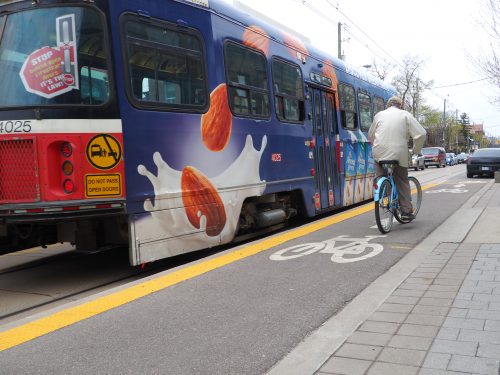 Where a person cycling in a cycle track approaches a TTC bus which is stationary while passengers are embarking or disembarking the vehicle, the person on a bicycle shall not pass the bus or approach nearer than two metres measured back from the rear or front entrance or exit. People cycling should yield to pedestrians and passengers, and may only proceed once the cycle track is clear.
Where a person cycling in a cycle track approaches a TTC bus which is stationary while passengers are embarking or disembarking the vehicle, the person on a bicycle shall not pass the bus or approach nearer than two metres measured back from the rear or front entrance or exit. People cycling should yield to pedestrians and passengers, and may only proceed once the cycle track is clear.
Passing in the Bicycle Lane
When approaching a slower person cycling in a bicycle lane, it is important to:
- Use your bell to notify the person of your presence
- Shoulder check on your left to ensure the route is clear
- Pass on the left leaving at least one metre clearance
If passing at a particular section is not safe (for example, if the cycle track section is too narrow or busy live traffic lane), wait behind the person cycling until it is clear to overtake.
Cycling with Children
General guidelines
- Teach children to obey the rules of the road and ensure they are always wearing a helmet.
- Practice riding in a safe, controlled environment.
- Children learn to balance and handle a bicycle many years before they are able to develop a sound judgment about traffic and a realistic appreciation of risk. Children aged nine years old and under should be supervised by an adult when they cycle.
Infants
- Never carry a baby in a front chest carrier or in a backpack. If you want to cycle with your infant, the only safe option is in a child carrier or bicycle trailer, but it is advised wait until your child is able to sit up alone.
- An infant must always wear a helmet when cycling with an adult. If the child is uncomfortable or in distress, it may be preferable to try again when the child is older.
Toddlers
- Children should be at least 12-16 months old before accompanying an adult on their bicycle, and should support the weight of their head while wearing a helmet.
- Using a trailer or a rear seat depends on your riding circumstances, ability and personal preference. A trailer tends to be more stable, and allows more room for toys and snacks, but the child is further away from you and low to the ground.
- Trailers are not suitable in high vehicle traffic situations, as children are not highly visible and may be bothered by loud noise and vehicular pollution. If using a trailer in high vehicle traffic is necessary, it is preferable if another adult can cycle behind the trailer.
- Bicycle seats mean your child is close to you, but the centre of gravity shifts higher and further back, making your bicycle unstable. Practice with a twenty-five pound bag of potatoes before you strap your child into the seat. A novice or inexperienced adult should avoid adding a bicycle seat.
Young children
- Teach your child to cycle in a park or on a quiet, residential street. For travelling further distances, use a trailer bicycle, which attaches to your seat post and allows a child to sit on the seat post while holding the handlebars and pedaling.
- Ensure that children are aware of hazards when cycling on sidewalks, such as cars backing out of or pulling into driveways, obstacles, uneven pavement and pedestrians.
- Teach children the rules of the road, even when cycling on a trail, such as: people should cycle on the right, ride in a straight line, be courteous with other users, and communicate using their bell or voice.
Teaching children about sidewalk cycling
- No person age 14 and older may ride a bicycle on a sidewalk.
- Always yield to pedestrians. Dismount and walk your bicycle or place your feet on the ground to allow pedestrians to pass.
- Ride slowly.
- Always walk your bicycle through a crosswalk or crossover (fines apply if not followed).
- Use a bell or horn to let pedestrians know that you are there.
- Make eye contact with drivers at driveways, laneways and at intersections, and be prepared to stop.
To teach skills and confidence in riding on the road, the City offers CAN-BIKE cycling courses for children and adults.
Crossing Streetcar or Railway Tracks
Safely cross streetcar tracks
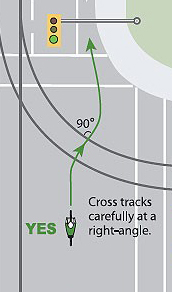 Use extra caution when crossing streetcar and railway tracks to avoid falls due to trapped wheels in the tracks. Always cross tracks at right angles, even when cycling over slots, cracks in the pavement or sewer grates.
Use extra caution when crossing streetcar and railway tracks to avoid falls due to trapped wheels in the tracks. Always cross tracks at right angles, even when cycling over slots, cracks in the pavement or sewer grates.
Your lane position to cross streetcar tracks at a right angle will depend on the angle of the tracks and the grade of the road. Shoulder check and signal your intentions to road users behind you. Use the following technique to safely cross the tracks:
- When approaching streetcar tracks, slow down.
- Stop pedaling, and position your feet so that your cranks are in a position horizontal to the ground, and lift out of your seat so that you are using your arms and legs to balance.
- You will be able to absorb the bump by using your arms and legs instead of bouncing on your seat.
If you are not comfortable riding over the tracks, whether it is due to multiple tracks at an intersection, difficult track angles, or heavy traffic, pull over to the curb, dismount and cross the intersection as a pedestrian.
Streetcar tracks become more slippery when wet. Use caution when riding in the rain or in winter weather.
Passing or stopping behind streetcars
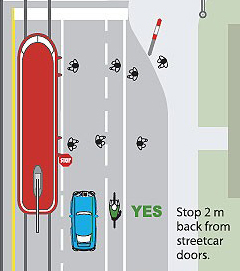 By law, you must pass streetcars on the right. When a streetcar stops to allow passengers to enter or exit, you must stop two metres behind the rear door until all passengers have boarded and disembarked on the sidewalk.
By law, you must pass streetcars on the right. When a streetcar stops to allow passengers to enter or exit, you must stop two metres behind the rear door until all passengers have boarded and disembarked on the sidewalk.
When TTC passengers are exiting the streetcar, wait for them to cross to the sidewalk before passing.
Cycling in the Winter
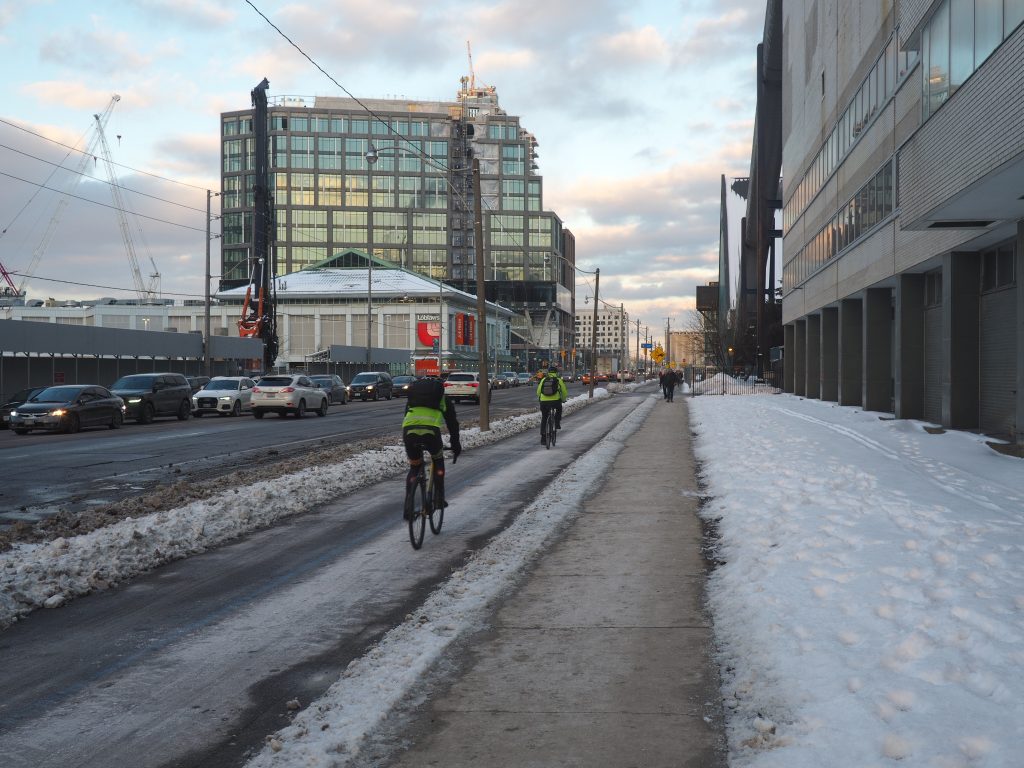 Providing clear and safe bikeways in winter encourages more people to cycle on city streets and trails.
Providing clear and safe bikeways in winter encourages more people to cycle on city streets and trails.
Learn more about winter cycling route planning, bike maintenance and safety techniques.
Staying Visible to Road Users
Be Visible
People cycling are safest when they are visible to other road users. Position yourself correctly on the road to be part of the flow of traffic, which increases visibility.
Be Vigilant
People cycling should be aware of their surroundings and anticipate obstacles, other road users and changes in infrastructure. Avoid wearing earphones or using your phone for calls or texting while cycling.
Be Predictable
People cycling are predictable when they ride in a straight line and communicate (signal) their intentions about changing position or direction. By riding in a straight line, it is easier for surrounding traffic to predict your actions.
Ride one metre away from the curb, avoid the gutter, and stay away from opening doors along parked cars. When cycling through an intersection, avoid moving into the right-turn lane, as this indicates to drivers that you intend to turn right. Instead, travel in the right-hand through lane.
Positioning at Intersections
At traffic lights, it is not safe to overtake (on the right), so either wait your turn or consider overtaking (on the left) to advance before pulling in to the flow of traffic.
Be Aware of Large Vehicles
Never cycle in a driver’s “blind spot,” as they are unable to see you if they turn. Always maintain enough distance behind or in front of any large vehicle so the driver can see you. If you are unable to see the driver’s eyes, they are unlikely to see you.

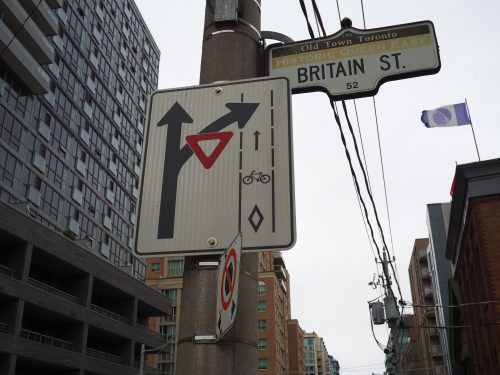
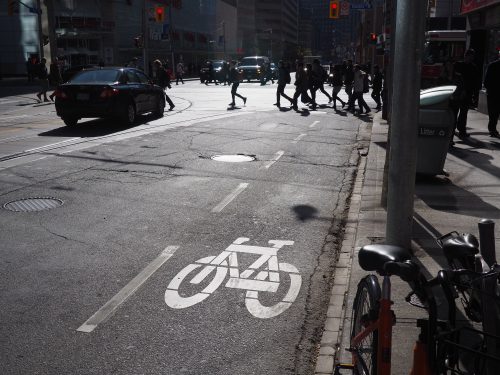
 For a one-way street with a contra-flow lane traveling in the opposite direction of motor traffic, the “bicycles excepted” sign is utilized. This tells drivers that they cannot legally travel in the specified direction, while allowing people cycling to use the designated contra-flow facility.
For a one-way street with a contra-flow lane traveling in the opposite direction of motor traffic, the “bicycles excepted” sign is utilized. This tells drivers that they cannot legally travel in the specified direction, while allowing people cycling to use the designated contra-flow facility. Where a person cycling in a cycle track approaches a TTC bus which is stationary while passengers are embarking or disembarking the vehicle, the person on a bicycle shall not pass the bus or approach nearer than two metres measured back from the rear or front entrance or exit. People cycling should yield to pedestrians and passengers, and may only proceed once the cycle track is clear.
Where a person cycling in a cycle track approaches a TTC bus which is stationary while passengers are embarking or disembarking the vehicle, the person on a bicycle shall not pass the bus or approach nearer than two metres measured back from the rear or front entrance or exit. People cycling should yield to pedestrians and passengers, and may only proceed once the cycle track is clear. Use extra caution when crossing streetcar and railway tracks to avoid falls due to trapped wheels in the tracks. Always cross tracks at right angles, even when cycling over slots, cracks in the pavement or sewer grates.
Use extra caution when crossing streetcar and railway tracks to avoid falls due to trapped wheels in the tracks. Always cross tracks at right angles, even when cycling over slots, cracks in the pavement or sewer grates. By law, you must pass streetcars on the right. When a streetcar stops to allow passengers to enter or exit, you must stop two metres behind the rear door until all passengers have boarded and disembarked on the sidewalk.
By law, you must pass streetcars on the right. When a streetcar stops to allow passengers to enter or exit, you must stop two metres behind the rear door until all passengers have boarded and disembarked on the sidewalk. Providing clear and safe bikeways in winter encourages more people to cycle on city streets and trails.
Providing clear and safe bikeways in winter encourages more people to cycle on city streets and trails.